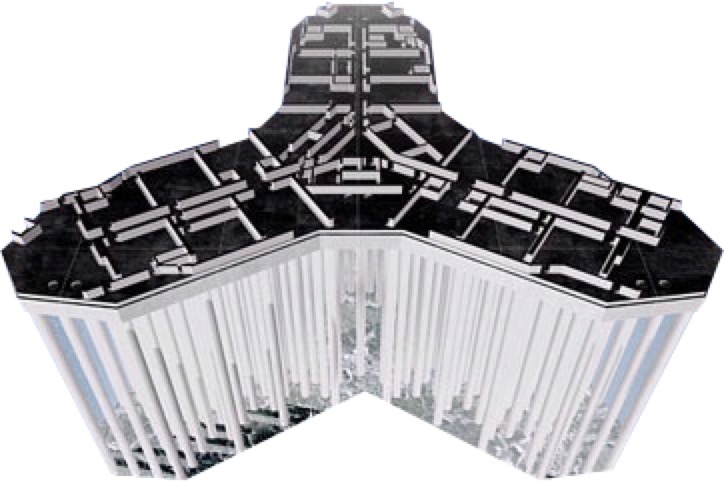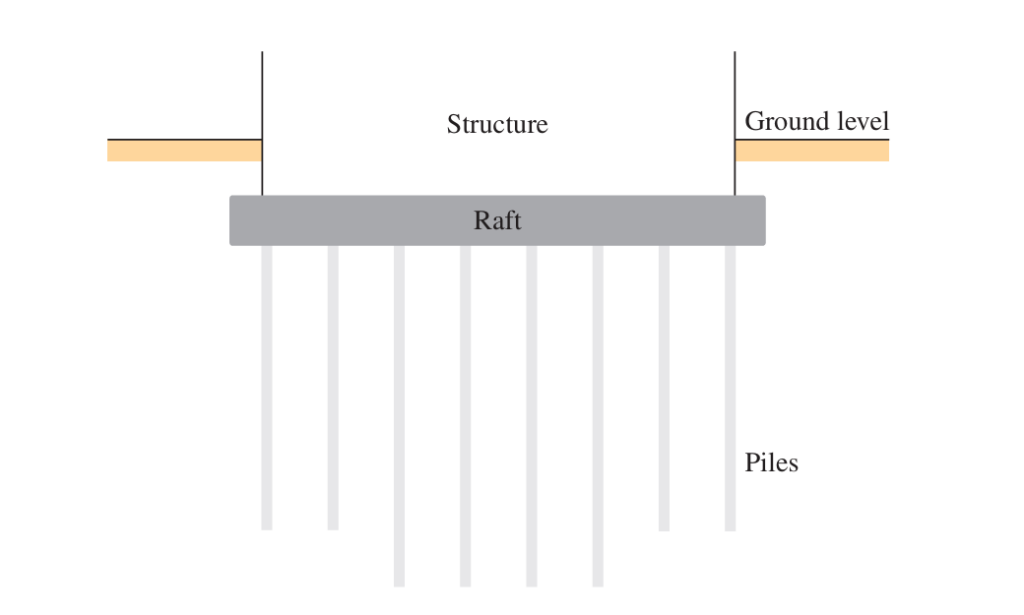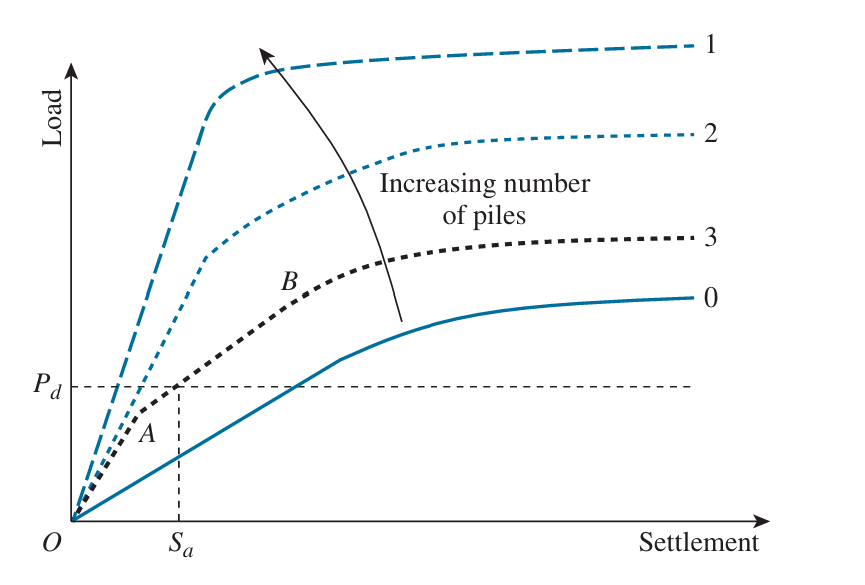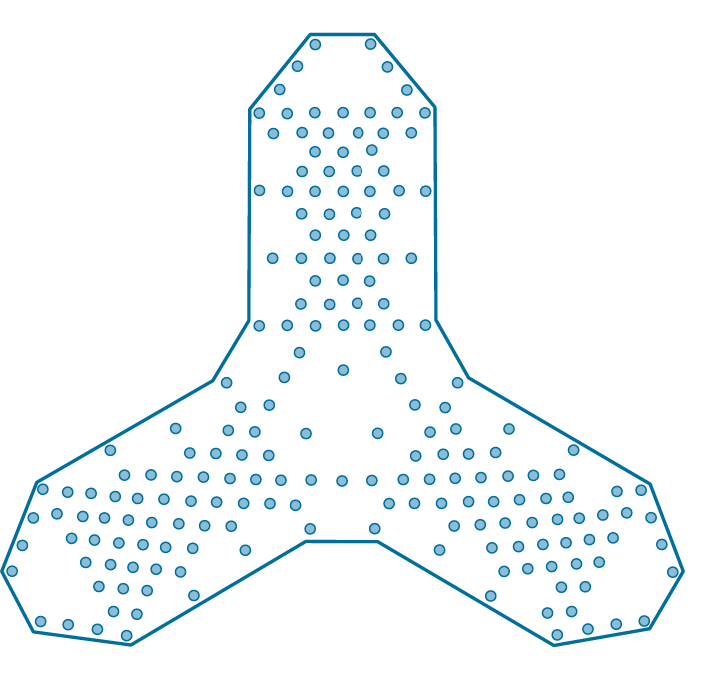The article explores the design of piled raft foundation, discussing the components, design philosophies, analysis methods, and a real-world case study.

Piled raft foundations combine the benefits of pile and raft systems into a single, highly efficient foundation solution. This innovative system is increasingly popular for its ability to handle heavy loads while controlling settlement economically. Tall buildings such as the Burj Khalifa in Dubai and the Petronas Towers in Kuala Lumpur have showcased the successful implementation of this foundation type.
A piled raft (Figure 1) differs significantly from a pile group foundation. Whereas a pile group uses a concrete pile cap to transfer loads to piles, often neglecting the cap’s contribution to bearing capacity, a piled raft integrates the raft into the load distribution system, allowing it to carry a significant portion of the load while piles reduce settlement and enhance stiffness. This dual role reduces the number of piles that would otherwise have been required, thereby, minimizing costs.

Piled rafts are mostly used when settlement considerations limit the applicability of raft-only foundations or when piles alone would be too costly. These foundations are most effective in stiff clays and dense sands but unsuitable for loose sands, soft clays, or soils with shallow compressible layers.
The following sections discuss the components, design philosophies, analysis methods, and a real-world case study.
Components of a Piled Raft Foundation
A piled raft foundation comprises three main components: the raft, the piles, and the soil.
The raft serves as the primary load-distribution element. It is the component that distribute loads directly to the ground. Thus, minimizing stress concentrations and providing stability for the structure.
The piles function primarily as settlement reducers rather than the main load carriers. The piles aid the transfer of loads to deeper and stiffer soil strata, thereby enhancing the overall stiffness of the system and reducing differential settlements. Their strategic placement under heavily loaded areas ensures effective load transfer and minimizes settlements.
Lastly, the soil plays a crucial role by supporting the foundation and interacting with both the raft and the piles. Soil properties, including stiffness, density, and compressibility, significantly influence the load-sharing mechanism and the overall behavior of the foundation. Understanding these interactions is essential.
Load Sharing Mechanisms
In an optimally designed piled raft, the raft carries 20-40% of the total load. This shared responsibility significantly reduces raft thickness, bending moments, and shearing forces compared to a raft-only system.
The raft directly supports the load over its contact area, while piles reduce settlement by providing stiffness and load transfer to deeper strata. This results in the following advantages:
- Reduced Settlement: Piles mitigate both total and differential settlements.
- Improved Load Distribution: The raft bears substantial loads, reducing the number of piles required.
- Cost Efficiency: Fewer piles translate into significant cost savings compared to traditional pile group systems.
Design Philosophies of Piled Raft Foundations
Designing a piled raft foundation follows three main philosophies, each suited to different project requirements and soil conditions. These approaches determine how loads are distributed between the raft and piles and how settlement is controlled.

Conventional Design (Curve 1)
This focuses on using piles to carry the majority of the load. The piles are designed with a high safety factor, often around 2.0, to ensure stability. In this approach, the raft contributes minimally, primarily acting as a stabilizing element rather than a major load-bearing component. This method is particularly effective for high-load scenarios where controlling settlement is the primary concern.
Creep Piling (Curve 2)
This involves designing piles to operate closer to their ultimate capacity, reducing the number of piles needed. The raft in this case plays a more significant role in carrying the load, sharing the responsibility with the piles. This approach balances efficiency and cost-effectiveness, making it suitable for projects where resource optimization is critical without compromising settlement control.
Ultimate Capacity Design (Curve 3)
Curve 3 fully mobilizes the piles to their maximum capacity, allowing them to carry as much load as possible. The raft handles the residual load, providing stability and additional support. This design minimizes differential settlement, making it ideal for critical projects that demand precise control over settlement, such as high-rise structures and sensitive industrial facilities.
Key Considerations in Piled Raft Design
Effective design of piled raft foundations requires attention to several critical factors to ensure performance and stability.
Pile Spacing and Layout
The placement and layout of piles play a vital role in reducing settlement, particularly in heavily loaded areas. Piles may be arranged uniformly or strategically to address site-specific conditions. Typical spacing ranges from 2.5 to 8 times the pile diameter, balancing structural requirements and economic efficiency.
Settlement Control
Settlement control is another essential aspect. Total settlement must stay within acceptable limits, which often range between 50 and 75 mm for piled rafts. Minimizing differential settlement between different sections of the raft is equally important to avoid structural distortions and uneven load transfer.
Raft Stiffness
The raft’s thickness depends on the building loads and soil characteristics, typically varying between 2 and 4 meters. Proper raft thickness enhances load distribution while maintaining structural integrity and minimizing material usage.
Soil – Structure Interaction
Interaction among the soil, piles, and raft significantly influences the load distribution and overall stiffness of the foundation. Advanced modeling techniques or simplified methods, such as the Poulos-Davis-Randolph (PDR) approach, help analyze these interactions effectively. These analyses are crucial for optimizing the design and ensuring that the foundation meets both performance and cost-efficiency goal
Simplified Analysis: Poulos-Davis-Randolph (PDR) Method
The PDR method is a widely used approach for preliminary design. It simplifies complex soil-pile-raft interactions into manageable calculations. The stiffness values for the raft (Kr), piles (Kp), and the combined system (Kpr) are critical parameters.
Stiffness Equations
The load sharing factor (X) and combined stiffness (Kpr ) are calculated using:
X=\frac{K_r(1-\alpha_{rp})}{K_p+K_r(1-2\alpha_{rp}}K_{pr}=\frac{K_p+K_r(1-2\alpha_{rp})}{1-\alpha^2_{rp}\times\frac{K_r}{K_p}}Here, αrp represents the interaction factor between piles and the raft. It varies from 0 (acting as a raft) to 1 (acting as a fully piled system).
Worked Example
To design a piled raft foundation for a 40-story building, several key parameters must be considered. The building has a footprint of 1350 m² and an average floor load of 12 kN/m². The piles are designed with a diameter of 1 meter, a length of 25 meters, and a center-to-center spacing of 3 meters. Using this data, the design will determine the number of piles required, the load each pile carries, and the proportion of the load shared between the raft and the pile
The total load on the foundation is given as:
N=n\times A_f\times w \\=40\times1350\times12=648MN
Where: N = total load; n = number of floors; Af = Footprint; w= floor load
Assuming the piles carry all the load initially, the number of piles needed can be estimated based on their capacity. If each pile is conservatively designed to carry 4.32 MN:
n_{piles}=\frac{N}{N_{pile}}=\frac{648}{4.32}=150pilesNow, to determine the proportion of the load carried by the raft and piles, the stiffness values of the raft and piles, along with their interaction factor, are used. Let the stiffness of the raft (Kr) be 800 MN/m, the stiffness of the pile group (Kp) be 2500 MN/m, and the pile-raft interaction factor (αrp) be 0.75. Using the formula:
X=\frac{K_r(1-\alpha_{rp})}{K_p+K_r(1-2\alpha_{rp}}Substitute the values:
=\frac{800(1-0.75)}{2500+800(1-2\times0.75)}=0.095This shows that approximately 9.5% of the total load is carried by the raft. The remaining load, carried by the piles, is:
100-9.5 =90.5\%
Thus, the raft carries 9.5% of the load, while the piles carry 90.5%. These proportions ensure that the piled raft system achieves an optimal balance between settlement control and material efficiency.
Finally, the combined stiffness of the piled raft system can be determined using:
K_{pr}=\frac{K_p+K_r(1-2\alpha_{rp})}{1-\alpha^2_{rp}\times\frac{K_r}{K_p}}Substituting the values:
=\frac{2500+800(1-2\times0.75)}{1-0.75^2\frac{800}{2500}} \approx2561MN/mThis stiffness value reflects the overall behavior of the system, ensuring adequate performance under the building’s load while maintaining settlement within allowable limit
Case Study: Burj Khalifa
The Burj Khalifa’s foundation demonstrates the efficiency of piled raft systems. At 828 meters, it required a foundation capable of handling enormous loads while controlling settlement. The 3.7-meter-thick raft distributed loads across the site, reducing stress concentrations. Its use of high-density, low-permeability concrete ensured durability against environmental factors, including high water tables and potential soil corrosion.

The foundation included 194 bored piles, each 1.5 meters in diameter and 47.5 meters long, socketed into weak rock layers (Figure 2). Spaced at 2.5 times their diameter, the piles enhanced stiffness and reduced settlement. Combined, the raft and piles consumed 45,000 m³ of concrete, reflecting the project’s massive scale.
Engineers limited settlement to 60 millimeters through rigorous design and testing. Static and dynamic pile load tests validated the foundation’s performance under vertical and lateral loads. The silty sand overlying weak calcareous sandstone presented geotechnical challenges, addressed through extensive site investigations and advanced modeling of soil-raft-pile interactions.
The foundation supported extreme conditions, including wind-induced cyclic loading, through innovative construction methods. This design highlights the adaptability of piled rafts in managing heavy loads, complex soils, and structural demands.
Conclusion
Piled raft foundations have proven to be very effective foundation solution, offering a reliable, cost-effective solution for high-rise construction. As demonstrated in the Burj Khalifa, meticulous design and innovative construction practices make piled rafts indispensable in challenging construction scenarios.
See: Comprehensive Guide to Types of Raft Foundations
Sources & Citation
- Poulos, H. G. (2001). Pile Raft Foundations: Design and Applications. Geotechnique, Vol. 51, No. 2, pp. 95–113.
- Poulos, H. G., & Bunce, G. (2008). “Foundation Design for the Burj Dubai—The World’s Tallest Building.” Proceedings 6th International Conference on Case Histories in Geotechnical Engineering, Paper 1.47.
- Das, B. M., & Sobhan, K. (2019). Principles of Foundation Engineering (9th Edition). Cengage Learning.